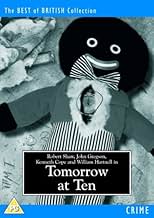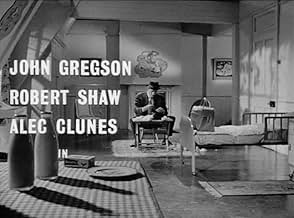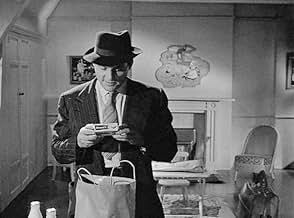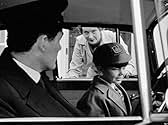It's a race against time for the police when they have to find a kidnapped boy imprisoned with a time bomb, after his abductor dies without revealing the child's whereabouts.It's a race against time for the police when they have to find a kidnapped boy imprisoned with a time bomb, after his abductor dies without revealing the child's whereabouts.It's a race against time for the police when they have to find a kidnapped boy imprisoned with a time bomb, after his abductor dies without revealing the child's whereabouts.
Featured reviews
Not bad, especially because of the exceptional actor who was Robert Shaw. John Gregson is also very good, natural. All the actors are very good, which makes the film bearable, since everything is just talk, just boring dialogue.
Just an errata and clarification for some of the above:
This little gem of a film is now under the ownership of Renown Films and is shown periodically on Talking Pictures TV (TPTV). The film was produced in 1962 as is confirmed by the titles (MCMLXII). It was released in 1963,but not well received, despite the presence of John Gregson who was a well known TV and film actor who often played the role of a police detective. However it was re-released in 1965, after Robert Shaw had appeared as the assassin Donald Grant in the second James Bond film From Russia with Love (1963). William Hartnel, who would subsequently play the first Dr. Who (1963 - 1966) also appears in a cameo as Freddie Maddox (frequently misspelled as Freddy), the father of George Marlowe (Maddox) and, with his wife Masie (Dorothy) Maddox are proprietors of The Golliwog Club.
Marlowe is not whistling the theme to Z-cars as he constructs the 'golliwog bomb', but rather is whistling the old English nursery rhyme 'Pop Goes The Weasel' and even sings a couple of lines. He is whistling an unintelligible song as he enters Abots Mead and walks up the stairs - as he approaches the second floor landing whistling can be heard in the background but it is evident from the shot that he is not whistling. The last segment as walks across the landing to the nursery does,however, resemble the theme tune of Z-cars.
The house from which Jonathan Chester is taken by the kidnapper is cited as being 14 Winnington Road, Hampstead, London N2. Whilst it is built in the neo-Georgian style of many of the larger houses towards the Highgate end of Winnington Road, it is certainly not the house which now stands there. It was in keeping with the area which wealthy financiers such as Anthony Chester (Alec Clunes) lived in the 50s and 60s.
The house at which Jonathan Chester (Piers Bishop) was kept hostage is portrayed as 'Abbots Mead' in Wimbledon, described by the estate agent, Mr. Tamplin (Frank Hawkins) as a detached house on three floors. Whilst the Wolseley police car is certainly seen driving at speed down the A3 expressway (now the Kingston Bypass) the actual location has not been verified.
This little gem of a film is now under the ownership of Renown Films and is shown periodically on Talking Pictures TV (TPTV). The film was produced in 1962 as is confirmed by the titles (MCMLXII). It was released in 1963,but not well received, despite the presence of John Gregson who was a well known TV and film actor who often played the role of a police detective. However it was re-released in 1965, after Robert Shaw had appeared as the assassin Donald Grant in the second James Bond film From Russia with Love (1963). William Hartnel, who would subsequently play the first Dr. Who (1963 - 1966) also appears in a cameo as Freddie Maddox (frequently misspelled as Freddy), the father of George Marlowe (Maddox) and, with his wife Masie (Dorothy) Maddox are proprietors of The Golliwog Club.
Marlowe is not whistling the theme to Z-cars as he constructs the 'golliwog bomb', but rather is whistling the old English nursery rhyme 'Pop Goes The Weasel' and even sings a couple of lines. He is whistling an unintelligible song as he enters Abots Mead and walks up the stairs - as he approaches the second floor landing whistling can be heard in the background but it is evident from the shot that he is not whistling. The last segment as walks across the landing to the nursery does,however, resemble the theme tune of Z-cars.
The house from which Jonathan Chester is taken by the kidnapper is cited as being 14 Winnington Road, Hampstead, London N2. Whilst it is built in the neo-Georgian style of many of the larger houses towards the Highgate end of Winnington Road, it is certainly not the house which now stands there. It was in keeping with the area which wealthy financiers such as Anthony Chester (Alec Clunes) lived in the 50s and 60s.
The house at which Jonathan Chester (Piers Bishop) was kept hostage is portrayed as 'Abbots Mead' in Wimbledon, described by the estate agent, Mr. Tamplin (Frank Hawkins) as a detached house on three floors. Whilst the Wolseley police car is certainly seen driving at speed down the A3 expressway (now the Kingston Bypass) the actual location has not been verified.
A surprisingly engaging feature sees John Gregson as a detective ("Insp. Parnell") brought into investigate the kidnap of the son of the wealthy "Chester" (Alec Clunes). Interestingly the kidnapper "Marlow" (Robert Shaw) has locked the child into an attic room in an unknown London address then gone to the man's home to demand the ransom in person - so we know all the characters from the start. Midway through, he there is an altercation and suffice to say the policeman has to try and track down the child from scratch. It's quite suspenseful, and the tight-knit cast keep the story moving well with quite a degree of jeopardy building, too.
George Marlow (Robert Shaw) devises what he thinks is the perfect kidnapping. He buys a doll and places a time bomb inside of it. He then picks a day when a chauffeur who usually takes the son of a rich man to school is ill, substitutes for him, and takes the boy to a large house that he has rented. He then locks the boy in an upper story room in the house with the doll-bomb in the same room. He goes to the rich man and says he wants fifty thousand pounds or else the bomb will go off and kill his son the next day at 10AM . Marlow says he plans to get on an international flight with the money and when he arrives at the destination he will call the rich man and tell him where the boy is so he can be rescued in time.
Not knowing anything but that the boy has been kidnapped, the nanny calls the police. Detective Inspector Parnell (John Gregson) arrives and tells Marlow he is not going anywhere, bomb or no bomb. Parnell has a long success of talking to suspects until they give something away, and he has almost 24 hours to do that here. In the meantime, Parnell is being opposed by the boy's father who even offers Parnell fifty thousand pounds to let the kidnapper go and by his own police commissioner who is a close friend of the rich man. And there are a couple of ironic plot twists along the way. I don't want to say any more than that.
This film could have gotten claustrophobic in a hurry if it was just Shaw and Gregson alone in a room verbally sparring for the length of the film, and I will tell you there is much more to it than that.
Not knowing anything but that the boy has been kidnapped, the nanny calls the police. Detective Inspector Parnell (John Gregson) arrives and tells Marlow he is not going anywhere, bomb or no bomb. Parnell has a long success of talking to suspects until they give something away, and he has almost 24 hours to do that here. In the meantime, Parnell is being opposed by the boy's father who even offers Parnell fifty thousand pounds to let the kidnapper go and by his own police commissioner who is a close friend of the rich man. And there are a couple of ironic plot twists along the way. I don't want to say any more than that.
This film could have gotten claustrophobic in a hurry if it was just Shaw and Gregson alone in a room verbally sparring for the length of the film, and I will tell you there is much more to it than that.
Detective Inspector John Gregson gets called in on a kidnapping. Robert Shaw has kidnapped a rich man's son and hidden him some place in London, with a bomb that will explode at 10 the following morning. Let him catch his plane to unextraditable Rio, and when he's safe, he'll phone in plenty of time. The man whose son has been abducted agrees. Gregson's superior agrees. Gregson thinks it's handing license to every would-be kidnapper in the country. He thinks he can break Shaw. He's making a good start, when the rich man attacks Shaw in a frenzy, rendering him unconscious.
It's a well performed little thriller, with the hurry-up-and-wait sequences very telling, and a few familiar faces in small roles; William Hartnell is present in a throwaway cameo, paired with Renee Houston. There's the stereotypical last minute race to save the boy, but even that ends with a twist.
It's a well performed little thriller, with the hurry-up-and-wait sequences very telling, and a few familiar faces in small roles; William Hartnell is present in a throwaway cameo, paired with Renee Houston. There's the stereotypical last minute race to save the boy, but even that ends with a twist.
Did you know
- TriviaAbbots Mead, the disused Victorian house (referred to in the film by its real name) where Marlow takes Jonathan after he has kidnapped him, was bought by film director Stanley Kubrick shortly after this film was made. He and his family lived there from 1965-1979 and he edited many of his films, such as A Clockwork Orange, in an outbuilding alongside the house.
- GoofsWhen Parnell and Grey first meet the local police officer near Chester's house, a cylindrical microphone windshield is very obvious at the bottom of the frame.
- ConnectionsFeatured in Tienes que ver esta peli: Mañana a las 10 (2022)
- How long is Tomorrow at Ten?Powered by Alexa
Details
- Release date
- Country of origin
- Language
- Also known as
- Chance to Live
- Filming locations
- 91 Winnington Road, Hampstead, London, England, UK(14 Winnington Road - the Chesters' house)
- Production company
- See more company credits at IMDbPro
- Runtime1 hour 20 minutes
- Color
- Aspect ratio
- 1.37 : 1
Contribute to this page
Suggest an edit or add missing content
































